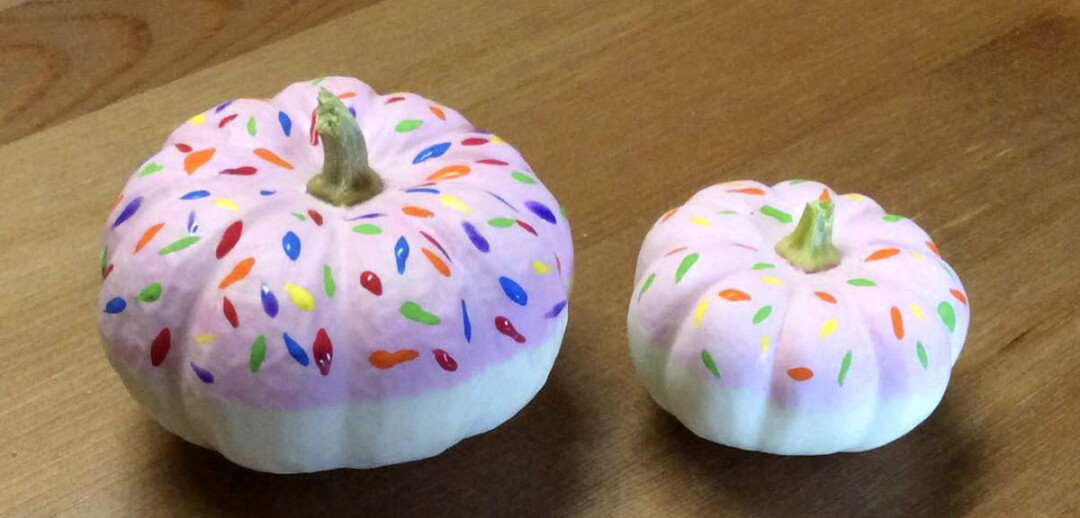To Carve or to Craft? Both Carving and Painting Have Their Pros and Cons
author & photographer by Yia Lor |

’Tis the season for everything pumpkin, so step aside, summer! Jack-o’-lanterns are here to stay – at least through Halloween. For many families, carving up that giant orange fruit (yes, it’s a fruit!) is a time-honored tradition that symbolizes this spooktacular holiday. Before the pumpkin came along, though, did you know that large turnips, gourds, and even potatoes served as early canvases? Later on, pumpkins were found to be bigger and easier to carve, and people have been scooping stringy pumpkin guts ever since! In recent years, painting and otherwise crafting pumpkins – without slicing them up – has become trendy. Although probably not as messy as grabbing a handful of slimy seeds, crafting pumpkins can be just as fun. Below are the advantages and disadvantages of each method followed by some helpful tips and hints that every parent should know when carving out some fun and crafting boo-tiful pumpkins.
CARVING
The good news: That orange smiling jack-o’-lantern sitting on the porch is the most recognizable symbol of Halloween. When you carve your pumpkin, you’re taking part in a tradition that’s been around for centuries. How cool is that? After you’re done carving, you can also light up your masterpiece with a battery-operated tea light to give it that spooky inner glow. Not only that, carving pumpkins means you can treat yourself to some roasted seeds after your hard work. The bad news: One you start slicing into it, a pumpkin doesn’t last very long, so you have to find time to carve your pumpkin seven to 10 days before Halloween. Carving is very messy, so be prepared to lay out lots of newspaper. It can also be a dangerous activity because you’ll need knives and carving tools, which can become slippery and difficult to use especially with younger children.

CRAFTING
The good news: This is a newer trend that anyone can enjoy, as it is safe and equally fun! Unlike their carved counterparts, crafted pumpkins are usually kept whole so they can last about a month indoors or two to three months outside. Another advantage: You don’t always need a real pumpkin, so you can head over to the craft store for an artificial one that you can decorate weeks ahead of time and keep forever. Worried that crafting won’t be as fun (or messy) as carving a pumpkin? Don’t be! Crafting allows you to get really creative. You can dip your pumpkin in glue and glitter, decorate it with stickers and paint, or even wrap it up in duct tape. The sky’s the limit! The bad news: Depending on your chosen materials, sometimes crafting a pumpkin can get spendy. To reduce the cost, make use of what you already have in your house, and let your imagination run wild. As with carving, crafting pumpkins can also be very messy, especially if you use glitter. Sure, it’s sparkly, but glitter is almost impossible to clean up and seems to find its way to almost every corner of the house.

TIPS & HINTS
Be sure to start with a clean, dry pumpkin and work on a flat surface.
Avoid pumpkins with punctures or soft spots as these tend to decay faster. A pumpkin with a thick and strong one- to two-inch stem will also last longer.
Keep plenty of rags nearby for messy hands and supplies.
Don’t have paint brushes? Use Q-tips, sponges, or even your fingers. The kids will definitely love that!
Leave the carving to the adults. Children can draw an outline for the pumpkin, pick out stencils they’d like to use, or craft pumpkins while you carve. This keeps them busy and safe!
A large metal spoon or an ice cream scoop are perfect for removing pumpkin seeds.
After carving, coat the inside and the cut portions of the pumpkin with petroleum jelly or pumpkin preserver. You can even dunk the whole thing in white vinegar to help keep it looking fresh.
This Halloween, let pumpkin carving and crafting get you into the spooky spirit! Both are sure to please kids of all ages and make for ghoulishly fun family activities.
6 TIPS FOR SAFE PUMPKIN CARVING
For all the frivolous fun it involves, Halloween can be a dangerous time of year – and we’re not talking about urban legends of poisoned candy. In fact, injuries around the holiday typically have more mundane causes: candles starting fires, trick-or-treaters stepping into traffic, and hand injuries from pumpkin carving. According to the American Society for Surgery of the Hand (ASSH), Halloween is one of the top three holidays for causing emergency room visits, and the largest share of these visits involve hand and finger injuries. To ensure that the only blood on your jack-o’-lantern is the fake kind, follow these tips from the ASSH:
CARVE YOUR PUMPKIN IN A CLEAN, DRY, WELL-LIT AREA.
Make sure your tools are clean and dry, too: Moisture can lead to slips, which can lead to cutting things other than your pumpkin.
USE ADULT SUPERVISION.
This one is common sense: Do you really trust your kiddos alone with sharp knives?
LEAVE THE CARVING TO the GROWN-UPS.
Let your kids be the creative ones, tracing or drawing their designs onto the pumpkin. But when it comes to the actual carving, let a grown-up take over. And really, carving isn’t all that fun. We all know the real excitement of making a jack-o’-lantern comes from scooping out the guts!
SHARPER ISN’T BETTER.
Sharp knives can get lodged in the pumpkin’s thick skin, requiring more force to pull them out. Sharp knives may also pass all the way through a pumpkin, piercing your hand on the other side.
USE A CARVING KIT.
Pumpkin carving kits are widely available and usually contain small, serrated saws that are designed to cut through pumpkins, not your fingers.
TREATING INJURIES.
If you do cut yourself, apply direct pressure. This should stop bleeding from minor cuts to the hand or finger within 15 minutes. If the bleeding continues after that, you may need to visit the ER.
Yia Lor is an aunt of eight who enjoys writing, storytelling, and playing hide-and-seek.






















